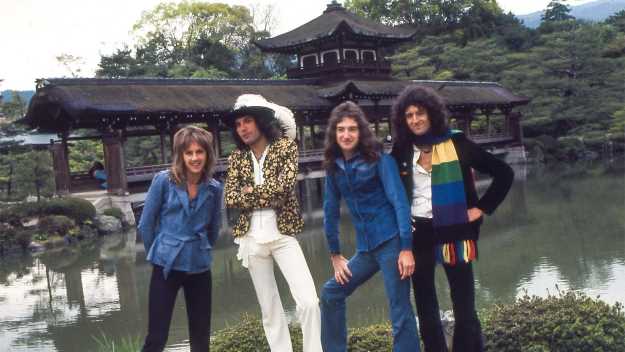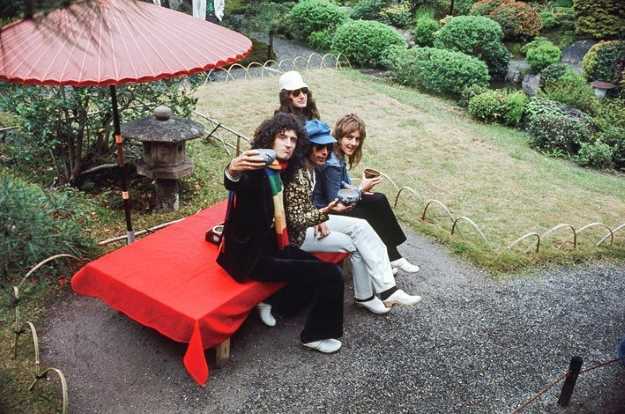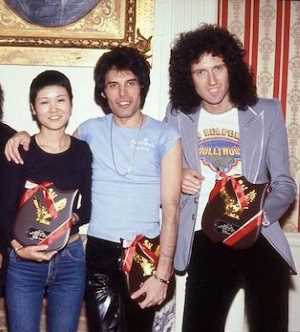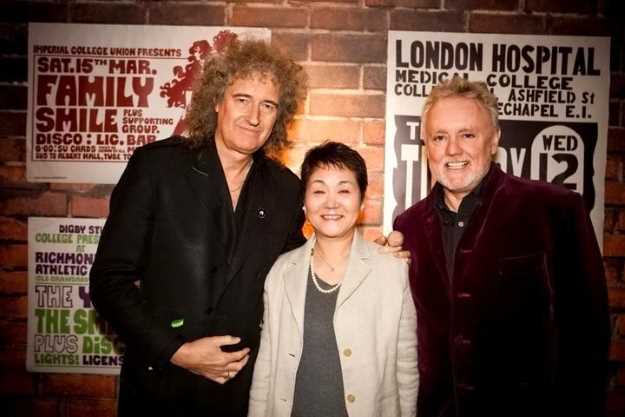|
Taken from Nippon (June 25, 2019)
Let Us Cling Together: Queen's Special Ties with Japan
The film Bohemian Rhapsody has sparked a renewed enthusiasm for Queen's music in Japan, where the band enjoyed its first success in the 1970s.
by Togo Kaoruko

Queen in Kyoto during its tour of Japan in 1975. From left: Roger Taylor, Freddie Mercury, John Deacon, and Brian May. PhotoCredit: Hasebe Ko/Music Life Archives |
Bohemian Rhapsody is now one of the biggest hits in Japanese box office history, with receipts of more than ¥13 billion between its nationwide opening in November 2018 and early May 2019, making it the ninth highest-grossing live-action film ever. The musical biopic depicting the career of British rock band Queen went viral on social media, and many of the most dedicated fans went to see the film multiple times at interactive, sing-along screenings. The film has once again made the band a talking point and a phenomenon. On the back of the film's success, its music is more popular than it has been in decades.
When Queen released its first single in 1973, the band was scorned by many critics and all but ignored in the United States. However, on their very first trip to Japan in April 1975, band members were astonished to find themselves mobbed by crowds of adoring female fans. This was before the breakthrough hit "Bohemian Rhapsody," which topped the British charts for nine weeks later that year. Queen came to Japan six times in the course of a decade, until their final visit in 1985. Togo Kaoruko, former editor-in-chief of Music Life magazine, remembers her first impressions of the then unknown band not long after that debut single was released.
What place did Japan have in Queen's career? "I think they had a special affection for Japan as the first place that appreciated their music. Back home, they were still being dismissed as the 'dregs of glam rock' and were totally unknown in America. And yet on their first visit to Japan they suddenly found themselves playing the Budokan, with hysterical fans in tears at the foot of the stage."
Rock Mania Hits Japan
Music Life was the first Japanese mainstream magazine to specialize in British and American popular music. The magazine scored a major scoop when it sent Hoshika Rumiko to London, where she became the first Japanese journalist to be granted an exclusive interview with the Beatles. When the Beatles came to Japan the next year, Togo, a high school student and self-described "Beatles fanatic," was among the crowds of frenzied fans in attendance. She dreamed of getting a job like Hoshino's, that had enabled her to meet the Beatles, and a few years later joined the editorial department at Music Life. She would experience the 1970s golden age of Japanese rock fandom from the frontlines.
"In the States, I think Woodstock in 1969 marked the beginning of a new era," she says, looking back on those days. "Rock music seemed to go from strength to strength. The Beatles split up in 1971, but after that a whole succession of major bands came and toured Japan-Grand Funk Railroad, Pink Floyd, Led Zeppelin. These concerts had a major impact and opened a lot of people's eyes to what an amazing genre rock had become."
"In those days, about 80 percent of the fans who listened to British and American bands were men. Young guitar players had three idols in particular: Jeff Beck, Eric Clapton, and Jimmy Page. The biggest bands were British hard rock groups like Led Zeppelin and prog rock bands like Yes and Pink Floyd."
And then came Queen. "I listened to a promo copy of 'Keep Yourself Alive' that the record company had sent to us, knowing nothing about them in advance. I was immediately struck by them. They sounded like a combination of early Led Zep and Yes, but with something new about them. Some of the more obsessive fans-the guys who used to compete to get their hands on the latest overseas releases before anyone else-started talking about the band's guitarist, like, 'Wow, this Brian May guy's pretty good.'"
But when the band's first album was finally released in Japan in March 1974, a year after its original release in Britain, and people saw how the band looked, "the young female fans became even more passionate about the band than the guitar nerds," recalls Togo.
"Because Queen still weren't widely known in the US back then, they weren't played on the American Forces Network-or FEN, the Far East Network, as it was known then-or covered in the foreign magazines. So all the young girls flocked to us for news about their latest heroes."
The Golden Age of Rock in Japan
Togo's first experience of Queen in the flesh came on a trip to New York in May 1974, when the band was opening for Mott the Hoople, the headlining band she had gone to cover. She was immediately struck by the strange charisma of vocalist Freddie Mercury and by the band's flamboyant glittery costumes. And she was impressed by the band's good looks, too-"they were much more handsome in real life than I'd expected from the photos I'd seen.
"There was something about Freddie, an aura of excitement and edginess, that I knew would appeal to Japanese girls, who tend to go for the androgynous, boyish type." And lo and behold, when the band played the Budokan on its first visit to Japan in 1975, many of the girls in the crowd fainted with excitement. "The arrival of these young 'rock girls' marked the beginning of a golden era for the genre in Japan," Togo says.
Shortly before Queen released its first record, the British music scene was dominated by the short-lived glam rock movement, centered on the otherworldly figure of David Bowie, with his gender-bending makeup and psychedelic outfits. Bowie was highly popular in Japan. "The 1970s was when shojo manga aimed at teenage girls were booming in Japan, and some presaged the later boys' love comics. There were characters who looked a lot like Bowie and Freddie!"
After the explosive popularity of its first visit to Japan in 1975, Queen held first place in the Music Life readers' poll for "Best Group" for eight consecutive years, until 1982. "Some guys used to have a prejudice that girls didn't really understand rock; but groups don't remain popular so long just because of looks. The fact that so many people have loved Queen for so long is simple: the music is good."
The Japanese market for imported rock music was growing massively at the time, with American bands like Kiss and Aerosmith attracting legions of converts around the same time.

Queen members take tea in a Kyoto garden, 1975. PhotoCredit: Hasebe Ko/Music Life Archives |
Conquering America

Togo with Freddie Mercury and Brian May on tour in New Orleans, Louisiana in October 1978. (Photo courtesy Togo Kaoruko) |
In 1977, the band made a radical shift in direction on its sixth album, News of the World, ditching the multitracking and other studio effects of its earlier efforts for a simpler, less lyrical, hard rock style. "We Are the Champions" became the band's first major US hit, making the Top 5 on the US singles charts.
"Fans in Japan split into two factions: those who prefer the glammed-up, aesthete style of early Queen, and fans of the band's stadium rock period, symbolized by the figure of Freddie with his short hair and mustache," Togo says. "I think most of the really enthusiastic fans prefer the early period. But in those days, making it big in the States was seen as an important status symbol, and I think the band deliberately changed their style as a strategic move to achieve that success. They achieved their aim and became megastars. But if you listen to Innuendo, which came out in 1990, a year before Freddie died, the sound has gone back to the old Queen. It made me realize that in the end they went back to where they had started from."
Getting to Freddie
"Queen was the band I interviewed most often, and who caused me the most difficulties during my time at Music Life. They seemed to follow me all through my career, from my early days as a fledgling editor to when I went freelance in 1990. So I have an attachment to them that goes beyond any question of personal likes and dislikes."
Togo was also lucky enough to be present at several moments that have gone down in musical history. She spent almost a whole day covering the band on location at Ridge Farm Studio during rehearsals for the album A Night at the Opera. These same recording sessions feature prominently in the Bohemian Rhapsody film. And she was also present at Wembley Stadium in July 1985 for Live Aid, the massive international charity event that forms the climax of the film.
The biggest source of headaches for Togo as she tried to gain access to the group for interviews was Freddie Mercury's personal assistant, Paul Prenter-who also appears prominently in the film as the villain of the piece.
"There's no doubt he was devoted to Freddie, but he wasn't an easy person to deal with. He was unreliable and often he simply wouldn't pass on my requests for an interview. We had several big fights. By the end, he turned around and ran away whenever he saw me coming."
During the late 1970s and early 1980s, Freddie Mercury became increasingly isolated. "As the other members of the band got married and had children, Prenter managed to convince him that he was the only one who really understood him. When I came to realize what was going on, it made me really angry."
When the band came to Japan again for what would be their final visit in May 1985, "I noticed that Prenter's name was missing from the list of tour members. I did a little skip for joy. Finally, I thought: Freddie's seen the light. I was able to carry out a one-on-one interview with Freddie that went much more smoothly than ever before. It was just before the Japan release of his solo album, Mr. Bad Guy, so that was presumably part of the reason why he wanted to talk, to promote his album. But he was very friendly and high-spirited."
He showed Togo the newly completed video for his song "I Was Born to Love You" over and over again, repeatedly pausing the video to explain the significance of particular moments or lyrics. "He could be quite exasperating," Togo says, "but you couldn't dislike him. He was like a big child." This interview turned out to be the last time she ever spoke to him directly.
At the time, rumors were rife that Queen was about to split up, and in fact after its performances in Japan the band had scheduled no tours, apparently considering a long sabbatical. Without the agreed appearance at Live Aid two months later, it's possible the band members might never have played together again. "I remember being there on the day, how energetic and exciting their performance was; it was quite overwhelming." Mercury used all his gifts as a natural showman to capture the hearts of the more than 70,000 people in attendance that day. "It was the salvation of Queen as a band, too. That rapturous welcome at a time when they had lost confidence in themselves gave them the impetus and strength to move forward again as a group."
Queen and Japan
Togo met Brian May and Roger Taylor again when she was in London in February 2011 to cover an exhibition to mark 40 years since the band's first gigs together. The two recalled how their first taste of stardom in Japan had been an important first step on the band's road to success.
One Queen song has special associations with Japan: "Teo Torriatte/Let Us Cling Together," which features a chorus sung in Japanese. The band offered the song for inclusion on the charity album Songs for Japan, a compilation of recordings by international artists put together to support people affected by the Great East Japan Earthquake in March 2011.

Togo in London with Brian May and Roger Taylor in February 2011. (Photo courtesy Togo Kaoruko) |
The song was originally included on the band's fifth album, A Day at the Races, released in 1976. It was apparently Mercury himself who had the idea of including Japanese lyrics on the track. When the band came back to Japan for another tour, Togo says, "Freddie wrote down the lyrics by hand and asked the woman who was working as their interpreter to translate them into Japanese."
Freddie Mercury had a special interest in Japan. He loved traditional Japanese crafts, and would always add to his collection whenever he came to Japan. He visited Kyoto several times. On a private trip to Japan in 1986, he visited the Kurita Museum of ceramics in Tochigi Prefecture. "Today there are pictures of that visit on display inside the museum, which has become something of a pilgrimage spot for Japanese Queen fans."
A New Generation of Fans
"Young people today are used to watching music videos on their phones, and I think seeing something like Live Aid on the big screen had a great impact on them," Togo says. "I think a lot of young people were surprised to learn that the songs they knew from sporting contexts or TV commercials were actually by Queen, and started to listen to the songs again on their music subscription services. The combined effect of the old fans with these new fans is what's driving this new wave of popularity."
Queen enjoyed a previous revival in Japan in 2004, but this time the boom is much bigger in scale, and shows no signs of coming to an end. The movements of Brian May and Roger Taylor are reported in the media on an almost daily basis, and are regularly shared on social media. In January 2020, the band will tour Japan with the American singer Adam Lambert on vocals.
"When I look at Roger and Brian today," Togo says with feeling, "and see the passion they have for what they are doing, I can feel their determination to pass on Freddie's spirit and Queen's music to another generation."
(Originally published in Japanese on May 31, 2019. Interview and text by Itakura Kimie of Nippon.com.
|